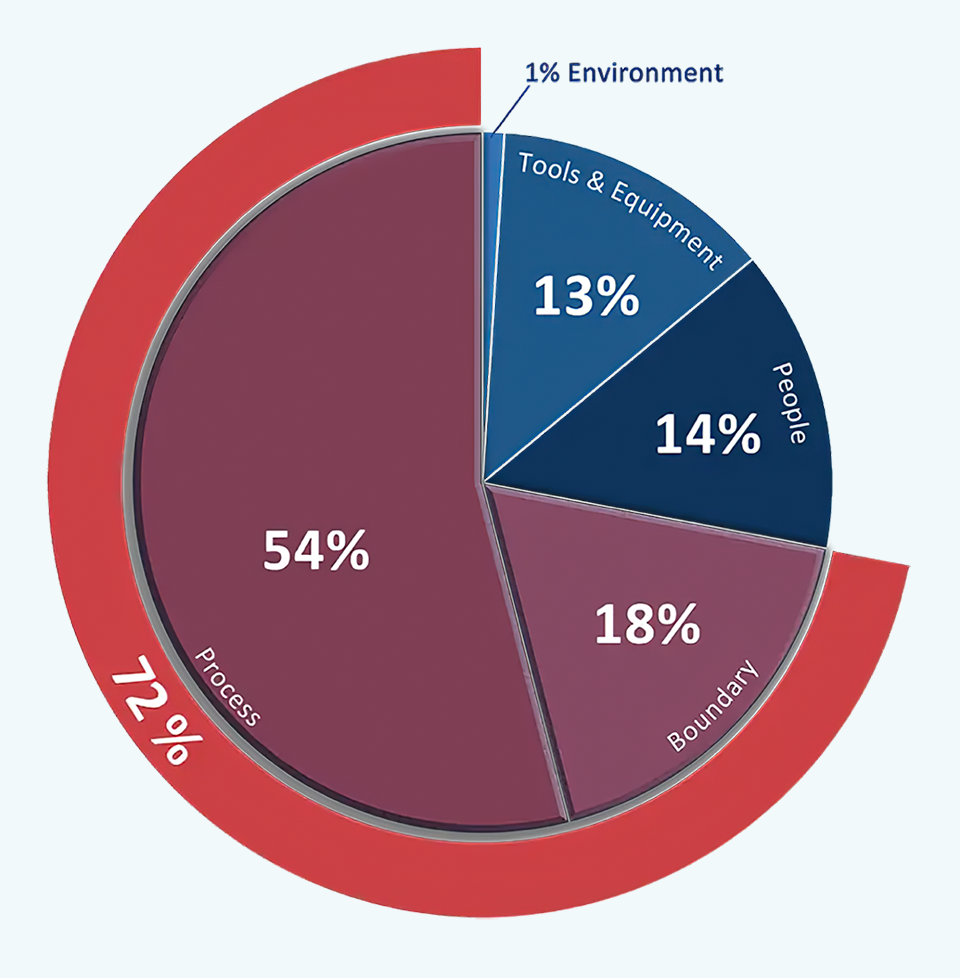A paradigm is a way we see the world, a structure that applies to both our business and personal lives. A paradigm is useful because it sets the ground rules for the game we are playing, helps us solve problems while playing that game, and establishes behavior norms on the playing field. We spend our whole lives trying to perfect our skills, knowledge, and actions to better our lives within personal paradigms.
A paradigm shift changes the game to a different set of rules and norms. In the paradigm shift created by Strategic Process Management, everyone goes back to zero. Skills and knowledge that made experts in the old paradigm become irrelevant. The new game and rules require a different set of skills, knowledge, and actions to succeed.
All paradigms will eventually hit a wall where new paradigms emerge with innovative solutions that break the old rules and solve previously unsolvable problems. What appeared to be impossible in the old paradigm suddenly becomes attainable. SPM represents a paradigm shift that allows businesses to move away from traditional organizational management. This is where leaders make their living, or not. Great leaders move organizations from outdated processes to new and better processes and, of course, the sooner the better. It requires equal amounts vision, drive, and courage. The more static and set in old ways the business is, the greater the challenge. This is why great leadership is so rare and valuable.
Strategic Process Management is a different paradigm for managing work. Leaders who adopt SPM embrace workflow management as the foundation for improving enterprise performance in a way that delivers sustainable competitive advantage.
If we simplify the essence of what must be managed and improved every day to achieve enterprise competitive advantage through SPM, we have marching orders. No matter the size or industry of your organization, the lasting and sustainable improvements of SPM can be yours, too:
1. Demonstrate Commitment: All successful performance improvement begins with senior leadership commitment. It’s not good enough that SPM is supported, it must be THE execution method for enterprise strategy to achieve long-term success.
2. Relentlessly Educate: SPM is a shift in the organizing and managing paradigm that renders old norms obsolete. It opens a whole new field of opportunity that requires giving employees the tools, education, and support they need. Focusing on basic tools for employees to improve performance is far more important than equipping a few with sophisticated equipment and letting everyone else fend for themselves.
3. Reorganize Around Work: Simplify the organization structure. Tackle the silos by rethinking responsibilities in terms of business process and flow of work. In this way, leadership can align work with enterprise purpose, goals, structure, and accountability.
4. Engage Experts: People who do the work are the experts to define and improve their work. There is no more powerful improvement strategy than to distribute responsibility and accountability to the entire workforce. Engage, empower, and hold employees accountable to make a difference.
5. Get the Right Metrics: Intentionally designed, meaningful metrics help leadership pull the enterprise towards the desired direction, while wrong metrics only serve as a barrier to desired change. The key is designing good measures that evaluate the extent to which the process purpose is being effectively and efficiently met, identifying who is responsible, and defining how the process obtains feedback.
6. Streamline and Align Work: Leaders are obligated to improve their business processes if they are dissatisfied with process outcomes, starting with defining them and aggressively removing waste and non-value-added activities. Simplified processes perform well when thoughtfully designed and seamlessly connected to their customer and supplier processes. This connectivity is the single most effective way to weave the “voice of the customer” through your entire enterprise.
7. Improve Enterprise Solutions: Define process and system deliverables with clarity, completeness, and understanding. Developing the boundary specifications between processes alleviates many root causes of many workflow problems.
8. Actively Manage Red Clouds: Processes often contain 25 to 75 Red Clouds that can be uncovered just by asking those who participate in the process where their problems lie. In a typical business system, this can easily include up to 500 opportunities to systematically manage through their resolution.
9. Matchup Resources: Resource capacities should be matched to work requirements for company assets, like its people, equipment, money, information technology, and facilities, to best support the company’s mission.
10. Centralize Data Management: Inaccurate and insufficient data collection wastes time and effort as it continues to be pushed along through a system or a value stream. Distributed data storage and ownership means the control needed to improve data collection and access throughout the enterprise is lacking.

11. Decentralize Knowledge Management: Knowledge is often centralized and difficult to access for those who need it when they need it. The enterprise’s valuable intellectual property should be owned and distributed to those who regularly use it.
12. Automate Where ROI Exists: Automating low complexity, high volume transactions such as Accounts Payable, Customer Service Call Center, and IT Help Desk often deliver high return on investment to the enterprise. High complexity, low volume processes like New Product Introduction, Strategic Planning, and Marketing Product Launch are less likely to provide the ROI to justify automation.
13. Fix What’s Broken: At the end of the day, improvement requires the implementation of new ways to yield a successful outcome. Broken processes cannot manage solutions to common problems and must be fixed.
14. Manage Sustainability: A lack of change management or control will interfere with the sustainability SPM provides for long-term success. Sustainability requires getting process definitions in place, identifying problems to be solved, implementing measures and analytics to solve those problems, holding the enterprise accountable for execution, and monitoring the results. Equally important are staff engagement and outcome ownership. A commitment to strengthening business processes as a core cultural and strategic element is key.
At the end of the day, it is the work that delivers the organization’s value proposition that creates profits. The work must be consistently and systematically improved for the organization to thrive.

